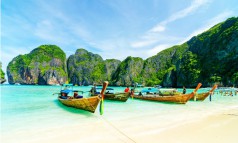



















Sunday, Feb 04, 2024 09:00 [IST]
Last Update: Sunday, Feb 04, 2024 03:24 [IST]
The story of Namo Buddha, also known as Mahasattva or Prince Mahasattva , is a legendary tale that predates the historical Buddha's lifetime. According to Buddhist folklore, the story takes place in a distant past, long before the time of Siddhartha Gautama. In the Panauti Valley of Nepal, ruled by King Maha Ratna, there was a compassionate prince named Mahasattva. While out hunting in the nearby forest, Prince Mahasattva encountered a starving tigress and her cubs. Moved by compassion, he decided to sacrifice himself to save them. Witnessing their suffering, he offered his own flesh to the tigress and her cubs, feeding them and ensuring their survival. This act of selfless compassion had profound spiritual significance, and it is said that the earth shook, and flowers rained from the sky in response to Prince Mahasattva 's noble deed. The gods and celestial beings were moved by his sacrifice and showered blessings upon him. When news of his sacrifice reached the kingdom, King Maha Ratna and his subjects were deeply moved by his act of compassion and bravery.
They honoured him by constructing a shrine at the site of his sacrifice, adorned with pure gold. This legendary tale has made the Namo Buddha Shrine in Nepal a sacred pilgrimage site, inspiring visitors with its rich history and spiritual significance.
Namo Buddha, located in the Kavrepalanchok District of Nepal, is renowned for its captivating natural beauty and spiritual significance. The area's picturesque landscape, resembling an eight-petaled lotus with a sky above mimicking the form of a wheel with nine spokes, provides a tranquil retreat away from urban life. The site experiences refreshing southern winds in the summer and a warm, gentle glow in the winter, creating an environment conducive to the practice of samadhi. The legend of Prince Mahasattva 's selfless sacrifice to a starving tigress and her cubs has made the Namo Buddha Shrine a sacred pilgrimage site, attracting visitors from around the world. The site's enduring allure draws pilgrims and spiritual seekers who seek solace and enlightenment amidst its serene surroundings.
The monasteries:
In addition to the Namo Buddha Shrine, the area surrounding Namo Buddha is home to several monasteries that contribute to the spiritual ambiance and heritage of the region. Thrangu Tashi Yangtse Monastery, founded by Khenchen Thrangu Rinpoche, is known for its traditional Tibetan architecture and role as a center for Buddhist teachings and meditation retreats. Namo Buddha Monastery, situated near the sacred site, houses a shrine dedicated to Prince Maha Satwa and other relics associated with Buddhist practice. Thrangu Sekhar Retreat Center offers retreat facilities for practitioners seeking solitude and spiritual renewal, while Takmo Monastery, founded by the 8th Karmapa, serves as a center for meditation and monastic activities.
The Namo Buddha Festivals:
These monasteries, among others in the region, preserve Buddhist teachings, nurture spiritual growth, and serve as places of refuge and reflection for practitioners and visitors alike. They contribute to the cultural and religious heritage of Namo Buddha, making it a revered destination for pilgrims and seekers of wisdom and enlightenment. Throughout the festival, attendees congregate at the ancient stupa and monastery to pay reverence to Lord Buddha and engage in customary Buddhist rites. Offerings such as butter lamps are made, mantras and prayers are recited, and meditation and other spiritual practices are observed. Monks and nuns from diverse Buddhist traditions journey to Namo Buddha to impart teachings and blessings to those present.
The Namo Buddha Jatara is also a time of jubilation and merriment, featuring traditional music, dance, and communal feasting. The local Newar community showcases its distinct cultural dances and musical performances, while visitors indulge in authentic Nepali cuisine and beverages.
With roots tracing back to ancient times when people sought the blessings of Lord Buddha at this revered site, the festival has endured and flourished over the centuries. Today, it stands as a significant occasion that unites individuals from various backgrounds in celebration and reverence of the teachings of Lord Buddha.
Contender for World Recognition:
Considering Panauti's designation as the birthplace of Prince Maha Satwa, a discussion arises about the inclusion of the Namo Buddha pilgrimage site in the UNESCO World Heritage Site list alongside Panauti, already on the tentative list for world recognition. Both Namo Buddha and the Ancient City of Panauti hold cultural and historical significance. Namo Buddha is revered as a sacred Buddhist pilgrimage site due to its association with the legendary tale of Prince Maha Satwa's selfless sacrifice, while Panauti is renowned for its well-preserved medieval architecture, temples, and cultural heritage.
UNESCO selects World Heritage Sites based on their outstanding universal value and efforts to preserve and protect them. Assessing the preservation levels and ongoing conservation efforts at Namo Buddha and Panauti is crucial for determining their eligibility for inclusion. Evaluation of integrity and authenticity is key for potential World Heritage Sites, considering factors like condition, historical accuracy, and degree of alteration. Both Namo Buddha and Panauti showcase these qualities, meeting UNESCO's criteria. Additionally, they contribute significantly to human culture and natural heritage. Given the shared boundaries between the municipalities of Namo Buddha and Panauti, there is potential for their eventual merger. This merger could ensure the long-term sustainability of conservation management for both heritage sites under the jurisdiction of a single local body.
(Email: vidhukayastha@gmail.com)
